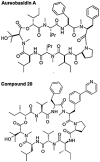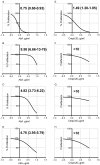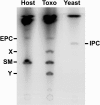The antifungal Aureobasidin A and an analogue are active against the protozoan parasite Toxoplasma gondii but do not inhibit sphingolipid biosynthesis
- PMID: 28486997
- PMCID: PMC5964465
- DOI: 10.1017/S0031182017000506
The antifungal Aureobasidin A and an analogue are active against the protozoan parasite Toxoplasma gondii but do not inhibit sphingolipid biosynthesis
Erratum in
-
The antifungal Aureobasidin A and an analogue are active against the protozoan parasite Toxoplasma gondii but do not inhibit sphingolipid biosynthesis - Corrigendum.Parasitology. 2018 Feb;145(2):156. doi: 10.1017/S0031182017000877. Epub 2017 Jun 9. Parasitology. 2018. PMID: 28595661 Free PMC article. No abstract available.
Abstract
Toxoplasma gondii is an obligate intracellular protozoan parasite of the phylum Apicomplexa, and toxoplasmosis is an important disease of both humans and economically important animals. With a limited array of drugs available there is a need to identify new therapeutic compounds. Aureobasidin A (AbA) is an antifungal that targets the essential inositol phosphorylceramide (IPC, sphingolipid) synthase in pathogenic fungi. This natural cyclic depsipeptide also inhibits Toxoplasma proliforation, with the protozoan IPC synthase orthologue proposed as the target. The data presented here show that neither AbA nor an analogue (Compound 20), target the protozoan IPC synthase orthologue or total parasite sphingolipid synthesis. However, further analyses confirm that AbA exhibits significant activity against the proliferative tachyzoite form of Toxoplasma, and Compound 20, whilst effective, has reduced efficacy. This difference was more evident on analyses of the direct effect of these compounds against isolated Toxoplasma, indicating that AbA is rapidly microbicidal. Importantly, the possibility of targeting the encysted, bradyzoite, form of the parasite with AbA and Compound 20 was demonstrated, indicating that this class of compounds may provide the basis for the first effective treatment for chronic toxoplasmosis.
Keywords: Toxoplasma; Aureobasidin A; bradyzoite; sphingolipid biosynthesis.
Figures






Similar articles
-
Inhibitory effect of aureobasidin A on Toxoplasma gondii.Antimicrob Agents Chemother. 2005 May;49(5):1794-801. doi: 10.1128/AAC.49.5.1794-1801.2005. Antimicrob Agents Chemother. 2005. PMID: 15855498 Free PMC article.
-
Sphingolipid synthesis and scavenging in the intracellular apicomplexan parasite, Toxoplasma gondii.Mol Biochem Parasitol. 2013 Jan;187(1):43-51. doi: 10.1016/j.molbiopara.2012.11.007. Epub 2012 Dec 16. Mol Biochem Parasitol. 2013. PMID: 23246819 Free PMC article.
-
IPC synthase as a useful target for antifungal drugs.Curr Drug Targets Infect Disord. 2004 Dec;4(4):311-22. doi: 10.2174/1568005043340597. Curr Drug Targets Infect Disord. 2004. PMID: 15578972 Review.
-
Sphingolipid synthesis as a target for antifungal drugs. Complementation of the inositol phosphorylceramide synthase defect in a mutant strain of Saccharomyces cerevisiae by the AUR1 gene.J Biol Chem. 1997 Apr 11;272(15):9809-17. doi: 10.1074/jbc.272.15.9809. J Biol Chem. 1997. PMID: 9092515
-
Mechanisms of Toxoplasma gondii persistence and latency.FEMS Microbiol Rev. 2012 May;36(3):717-33. doi: 10.1111/j.1574-6976.2011.00305.x. Epub 2011 Oct 4. FEMS Microbiol Rev. 2012. PMID: 22091606 Free PMC article. Review.
Cited by
-
Ceramide biosynthesis is critical for establishment of the intracellular niche of Toxoplasma gondii.Cell Rep. 2022 Aug 16;40(7):111224. doi: 10.1016/j.celrep.2022.111224. Cell Rep. 2022. PMID: 35977499 Free PMC article.
-
Everybody needs sphingolipids, right! Mining for new drug targets in protozoan sphingolipid biosynthesis.Parasitology. 2018 Feb;145(2):134-147. doi: 10.1017/S0031182017001081. Epub 2017 Jun 22. Parasitology. 2018. PMID: 28637533 Free PMC article. Review.
-
Toxoplasma ceramide synthases: Gene duplication, functional divergence, and roles in parasite fitness.FASEB J. 2023 Nov;37(11):e23229. doi: 10.1096/fj.202201603RRR. FASEB J. 2023. PMID: 37795915 Free PMC article.
-
Expression levels of inositol phosphorylceramide synthase modulate plant responses to biotic and abiotic stress in Arabidopsis thaliana.PLoS One. 2019 May 23;14(5):e0217087. doi: 10.1371/journal.pone.0217087. eCollection 2019. PLoS One. 2019. PMID: 31120963 Free PMC article.
-
Activities of anti-Toxoplasma drugs and compounds against tissue cysts in the last three decades (1987 to 2017), a systematic review.Parasitol Res. 2018 Oct;117(10):3045-3057. doi: 10.1007/s00436-018-6027-z. Epub 2018 Aug 8. Parasitol Res. 2018. PMID: 30088074
References
-
- Antczak M., Dzitko K. and Dlugonska H. (2016). Human toxoplasmosis-Searching for novel chemotherapeutics. Biomedicine and Pharmacotherapy 82, 677–684. - PubMed
-
- Azzouz N., Rauscher B., Gerold P., Cesbron-Delauw M. F., Dubremetz J. F. and Schwarz R. T. (2002). Evidence for de novo sphingolipid biosynthesis in Toxoplasma gondii. International Journal for Parasitology 32, 677–684. - PubMed
-
- Cerantola V., Guillas I., Roubaty C., Vionnet C., Uldry D., Knudsen J. and Conzelmann A. (2009). Aureobasidin A arrests growth of yeast cells through both ceramide intoxication and deprivation of essential inositolphosphorylceramides. Molecular Microbiology 71, 1523–1537. - PubMed
-
- Chowdhury M. N. (1986). Toxoplasmosis: a review. Journal of Medicine 17, 373–396. - PubMed
Publication types
MeSH terms
Substances
LinkOut - more resources
Full Text Sources
Other Literature Sources
Molecular Biology Databases

